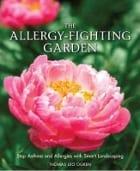 Stop Asthma and Allergies with Smart Landscaping
Stop Asthma and Allergies with Smart Landscaping
Written by Thomas Leo Ogren
Published by Ten Speed Press, 2015
Reviewed by Tom Benjamin
Do you or does someone you know or care about suffer from seasonal allergies? Here’s an important point to consider when designing or simply inhabiting the landscape around you: In the past ten years, allergy and asthma rates have continued to increase dramatically around the world. Some of the worst allergy areas are in cities, though vast areas of developed and agricultural lands also contribute significantly to allergy sufferers’ pain.
The Allergy-Fighting Garden provides an eye-opening message that much of the allergy and asthma misery today is caused by pollen. More pointedly, our past and current choices of plantings, and the levels of pollen they produce, have often had a huge deleterious effect on humans who happen to be breathing nearby. As author Thomas Leo Ogren shares, allergies are no laughing matter, and his deep passion for addressing the causes arose from the near loss of his wife from complications related to asthma.
Ogren is Agricultural Scientist who through decades of work created the ground-breaking Ogren Plant Allergy Scale (OPALS), a plant-allergy ranking system now used by the United States Department of Agriculture. The Allergy-Fighting Garden provides an accessible and revolutionary reference explaining: 1) How pollen is produced and distributed in the environment and 2) How we can work toward reducing health-threatening levels of pollen.
The book is split roughly into two sections. The first section lays out the scope and sources of the pollen-allergy crisis, including the botanical framework for pollen production, and then provides truly useful and innovative methods for reducing pollen in the environment. His discussion here of “Botanical Sexism,” or the traditional favoring of heavy pollen-producing male plants in conventional landscape design, is a real equation changer. Bring on the females of the species…especially the ones with real pretty berries! Leave the males locked in the tower!
Another very useful part of this first section describes the benefits and proper design of allergy-fighting hedges, surely a widely applicable technique to capture and remove pollen from one’s immediate environment. The discussion then turns to preventing spread of harmful molds, which can come from many common sources such as improper composting methods, so organic gardeners beware! One of the very useful admissions by Ogren covers the information that is lacking in this still-new field. To translate: Great research opportunities for current and future graduate students! The first half of the book concludes with an activist call-to-arms on how to fight allergies, or bad landscape choices, in your own community. Clearly, this issue is not one to be taken sitting down, especially given the considerable time required to undo past harmful practices and transform potentially large swaths of the landscape with healthier choices.
The strong foundation compellingly presented in the first half of the book frames the problem and sets out its cure. But it is the second section that will no doubt seal this book’s fate as an oft-turned-to industry standard reference: Categorizing the Allergy-Fighting Plants. Using Ogren’s own OPALS scale, a simple 1 to 10 allergy ranking, the author has compiled an ambitious A-Z encyclopedia of North American plants with regard to their allergy risk levels.
This encyclopedia provides an invaluable, cutting-edge tool for plant selection for practitioners and laypeople alike. And there are some big surprises, especially for those of us in the Northeast who aspire to “go native.” Did you know that many if not most of the oak tree selections (mostly male trees are available on the market today) are extremely heavy pollen producers? Also, ashes and many maples can be huge pollen sources – again related to heavy emphasis on male tree use. Same with black tupelo (males rank 8, females 1). Of course with any “complete” compilation, there is always the risk of leaving some plants out, and this reviewer noted a few additions he’d like to see. Perhaps, the next great contribution would be to further detail out Ogrens A-Z list by region, as the California-based author lists many plants that are found only in the western half of the continent. But, having this information now at the designer’s finger-tips is likely to have significant impacts on the nursery industry, just as the “go native” movement has had over the past few decades!
Ogren also provides a pretty comprehensive glossary of terms, as well as a useful list of references and Pollen Calendar. These elements round out the overall usefulness of the The Allergy Fighting Garden.
As Designers, we learn to compile and layer varied information about sites, identify the factors that form the basis of design out of which we synthesize design solutions. We look at topography, hydrology, soils, setbacks, solar access, wildlife habitat, client’s program, budget, etc. We are now compelled by Ogren to consider the very direct health impacts of our plant selections vis-à-vis allergenic reactions. Lucky for us we don’t need to have an allergic reaction to this new, daunting “layer” added to our design process because The Allergy-Fighting Garden provides us with considerable tools to address the problem head on.
About the Reviewer
Tom Benjamin, RLA, LEED-AP, Principal, Wellnesscapes LLC, is an independent registered Landscape Architect and LEED Accredited Professional (AP BD+C) practicing design and sustainability consulting and is Principal of Wellnesscapes. Tom has more than 20 years’ experience in environmental design and sustainability work often focused on green design, including energy, waste, water and food systems. In addition to residential restoration, Tom’s site planning work emphasizes low cost, low maintenance landscape solutions for healthcare, academic and senior institutions, public facilities, commercial and residential developments, large-scale solar farms and community farms/gardens. Tom teaches sustainable landscape design at the University of Massachusetts. He is the recipient of multiple awards, including three for his sustainable landscape design work at Kent Hospital located in Warwick, RI. Tom is also a Board Member of the Ecological Landscape Alliance (ELA).


